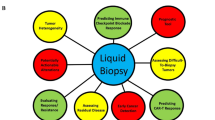Abstract
Circulating DNA released from cancerous tissues has been found to harbour tumour-associated alterations and to represent the molecular composition of the tumour. Recent advances in technologies, especially in next-generation sequencing, enable the analysis of low amounts of circulating DNA from body fluids. These “liquid biopsies” allow tumour genotyping and therapy monitoring without invasive procedures and offer the potential for early cancer detection.
Similar content being viewed by others
Literatur
de Bruin EC, McGranahan N, Mitter R et al. (2014) Spatial and temporal diversity in genomic instability processes defines lung cancer evolution. Science 346:251–256
Murtaza M, Dawson SJ, Tsui DW et al. (2013) Noninvasive analysis of acquired resistance to cancer therapy by sequencing of plasma DNA. Nature 497:108–112
Newman AM, Bratman SV, To J et al. (2014) An ultrasensitive method for quantitating circulating tumor DNA with broad patient coverage. Nat Med 20:548–554
Li M, Diehl F, Dressman D et al. (2006) BEAMing up for detection and quantification of rare sequence variants. Nat Methods 3:95–97
Leary RJ, Sausen M, Kinde I et al. (2012) Detection of chromosomal alterations in the circulation of cancer patients with whole-genome sequencing. Sci Transl Med 4:162ra154
Lawrence MS, Stojanov P, Mermel CH et al. (2014) Discovery and saturation analysis of cancer genes across 21 tumour types. Nature 505:495–501
Cataldo VD, Gibbons DL, Perez-Soler R et al. (2011) Treatment of non-small-cell lung cancer with erlotinib or gefitinib. N Engl J Med 364:947–955
Taniguchi K, Uchida J, Nishino K et al. (2011) Quantitative detection of EGFR mutations in circulating tumor DNA derived from lung adenocarcinomas. Clin Cancer Res 17:7808–7815
Sorensen BS, Wu L, Wei W et al. (2014) Monitoring of epidermal growth factor receptor tyrosine kinase inhibitor-sensitizing and resistance mutations in the plasma DNA of patients with advanced non-small cell lung cancer during treatment with erlotinib. Cancer 120:3896–3901
Thress KS, Paweletz CP, Felip E et al. (2015) Acquired EGFR C797S mutation mediates resistance to AZD9291 in non-small cell lung cancer harboring EGFR T790M. Nat Med 21:560–562
Mok T, Wu YL, Lee JS et al. (2015) Detection and dynamic changes of EGFR mutations from circulating tumor DNA as a predictor of survival outcomes in NSCLC patients treated with first-line intercalated erlotinib and chemotherapy. Clin Cancer Res 21:3196–3203
Author information
Authors and Affiliations
Corresponding author
Additional information
Steffen Dietz, Anja Riediger, Michael Thomas, Uwe Schirmer und Holger Sültmann (v. l. n. r.) Die AG Krebsgenomforschung (DKFZ/NCT Heidelberg) nutzt die Hochdurchsatztechnologien der Genomforschung zur Analyse genetischer Änderungen in Geweben und Blutproben von Krebspatienten. Ziel ist es, in Kooperation mit klinischen Partnerinstitutionen wie der Thoraxklinik Heidelberg (Prof. Dr. Michael Thomas), diese Marker in die klinische Diagnostik zu bringen.
Rights and permissions
About this article
Cite this article
Dietz, S., Riediger, A., Thomas, M. et al. Chancen und Grenzen der liquid biopsy für die Tumordiagnostik. Biospektrum 21, 731–733 (2015). https://doi.org/10.1007/s12268-015-0643-2
Published:
Issue Date:
DOI: https://doi.org/10.1007/s12268-015-0643-2




